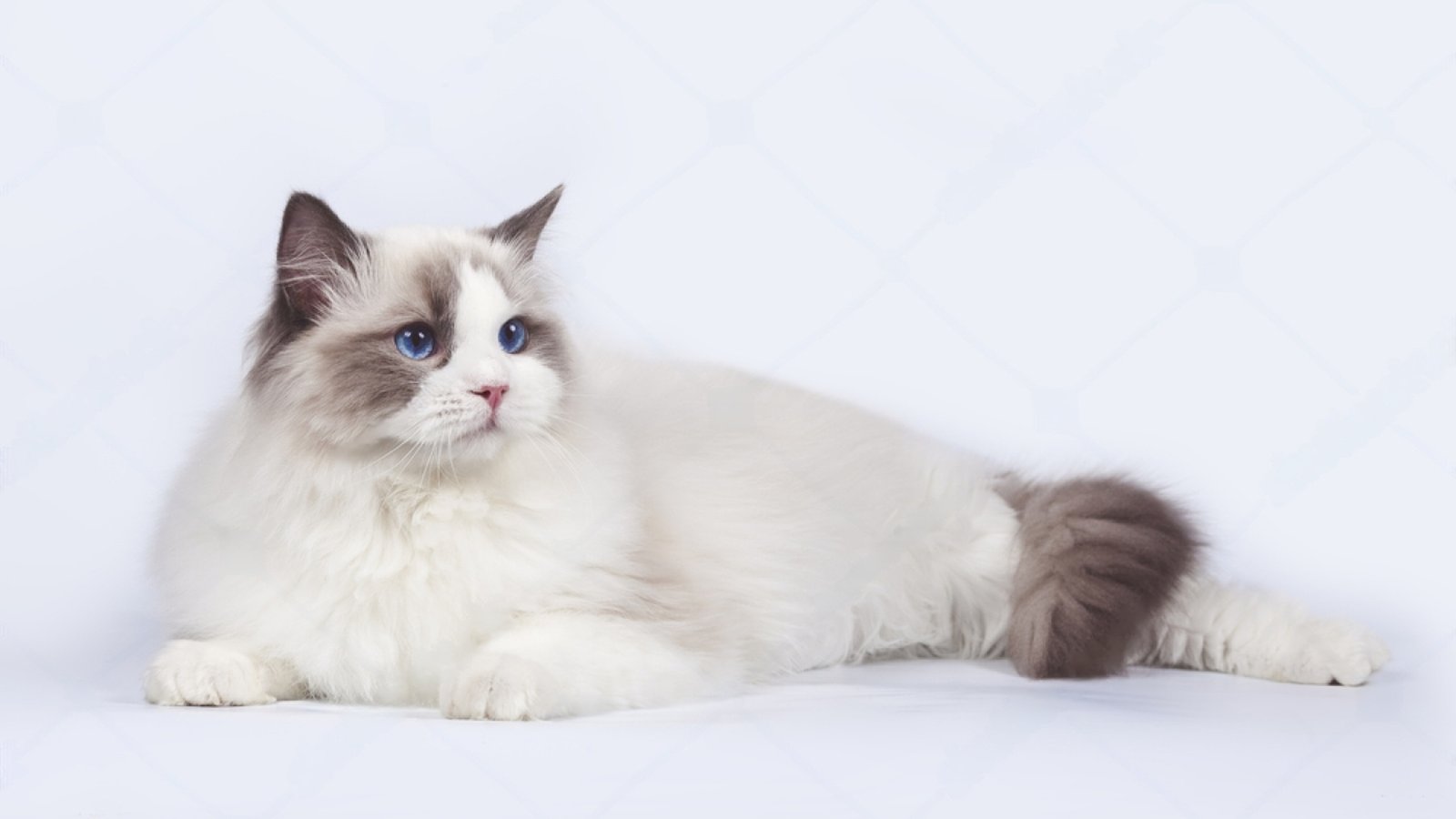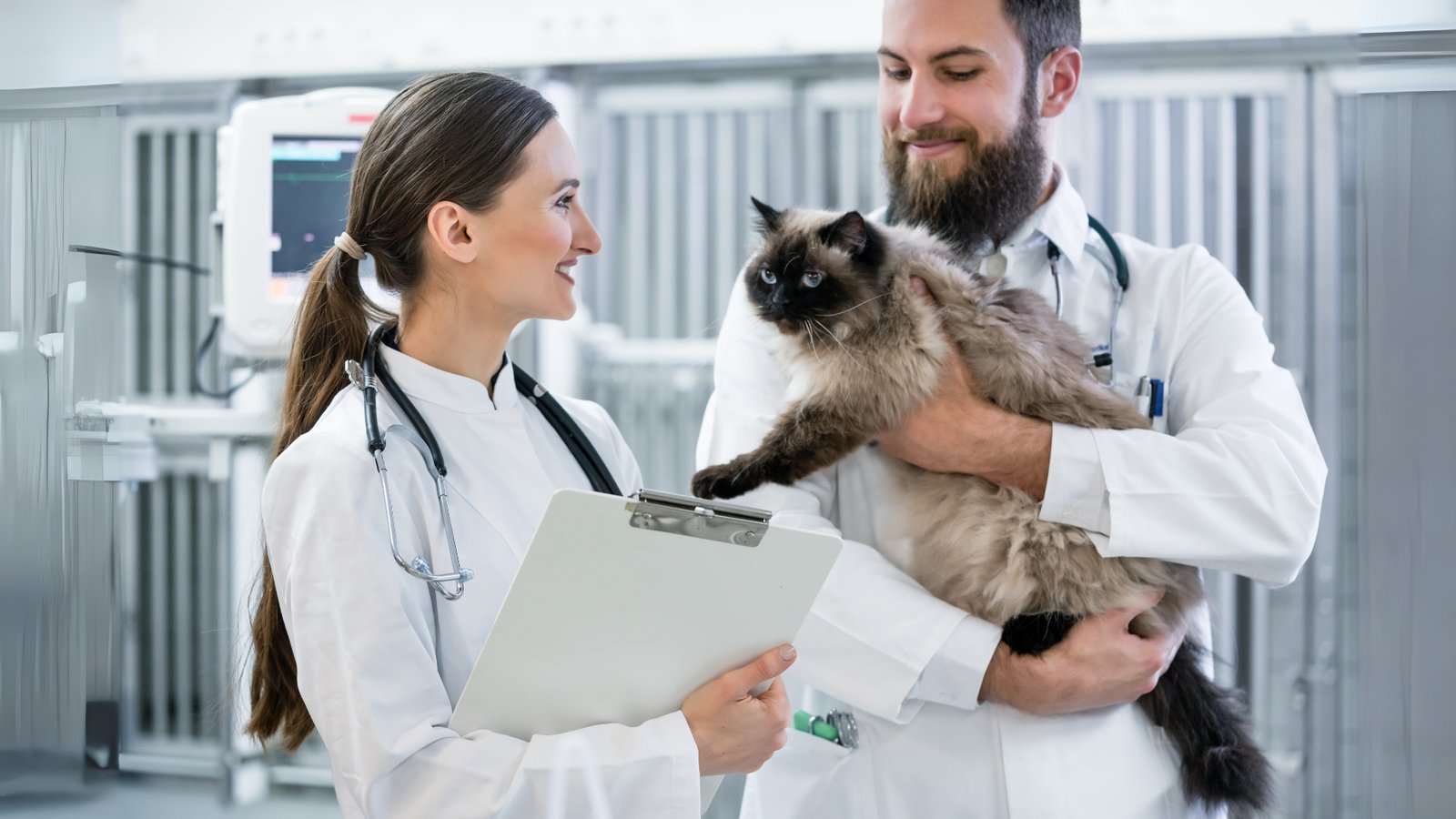Bicolor color and pattern can be seen in almost all cat breeds (Maine Coon, Persian, Birman, or even in feral cats) and the ragdoll cat is no exception.
Blue bicolor ragdoll cat is a most preciously exceptional color and pattern that has a medium-grade white color (40-60%) across the body, unlike other ragdoll patterns and colors.
Because of their adorably placid temperament, big dog-like size, and piercing sapphire eyes, blue bicolor ragdoll cats are a favorite among ragdoll fanatics, and it’s so easy to see why.
Blue Bicolor Ragdoll Breed Overview
- Weight – 10-20 lbs (6.80-9.07kg)
- Height – 23-28 cm
- Life Expectancy – 12-17 years
- Personality – Laid-back, affectionate, Placid, loyal.
- Get Along Well With – Solo, couples, families with kids & other pets.
Blue Bicolor Ragdoll Characteristics

- The points (face, ears, paws, and tail) of bicolor blue ragdolls are of darker grey (blue) with an upside down inverted ”V” mask and pinkish nose.
- The intensity of their blue color however fades towards the saddle (their back). The white manifests most prominently over their chest, belly, and front paws. From here, the white progresses up to the legs and extends to the sides of the body. Any patches or streaks on the white area of blue bicolor ragdoll cats are very minimal to nearly invisible.
- Show quality blue bicolor ragdoll cats have more of a symmetrical mask surrounding their eyes and wouldn’t extend off of the outer edge of the eye on either side. This is what TICA, the International Cat Association, calls the “hourglass marking.”
Genetics Of a Blue Bicolor Ragdoll
The genotype for a blue bicolor ragdoll cat fuses the dilution genes (d/d) with the bicolor white-spotting alleles (S/s). The blue color in their coat doesn’t even mean it’s blue. Just as we refer to seal point Ragdolls casually as brown, in this case, ‘blue’ is a fancy term for a grey hue. The genetic term for blue is in reality ‘diluted. To make things easier for you, we break it down into layman’s terms.
In the first place, to produce blue bicolor kittens (offspring), either one or both parents should carry the recessive dilution gene d/d.
- D/D (Two copies of Dilution Gene) – No dilution, solid color
- D/d (One copy of Dilution Gene) – 25% Diluted color, carrier for dilution gene
- d/d (No copies of Dilution Gene) – Fully diluted coat color
The d/d gene dilutes black-based pigments (like those in seal-point Ragdolls) into a lighter, cooler grey (“blue”). This dilution affects the pigment granules in the hair shaft and unevenly spreads them to create the characteristic silvery-blue tone.
The white spotting alleles are responsible for the bicolor pattern in ragdolls. For a bicolor pattern to show up on a ragdoll, there needs to be one dominant white allele present on either copy of the White Spotting gene.
- S/S or S/si (White spotting genes present) – Bicolor pattern present
- si/si (No white spotting genes present) – No bicolor pattern
Ragdoll Blue Bicolor Personality & Temperament

The blue point bicolor ragdoll cat lives up to the laid-back reputation of any ragdoll that you can ever come across. They are by far the sweetest, most docile cats that love to spend most of their time shadowing their owners or cuddling next to you on the couch.
Although blue bicolor ragdoll kittens aren’t so high-energy cats nor do they overly vocalize though, they thrive on lots of human attention and get stressed if left out for over 8 hours a day. You’ll often find them waiting patiently by the door when you leave, ready to tune in to your return with soft chirps, gentle nudges, and purrs.
How To Care For a Blue Bicolor Ragdoll
Diet & Nutrition
First off, blue bicolor ragdolls captivate hearts with their fluffy coats and blue eyes. Their large size means their diet should be of the right portion to fulfill their nutritional needs or daily calorie intake (250-300 Cal).
Besides, how much you should have to feed your bicolor raggies depends on their activity level, sex, age, and health. Ideally, feed them meat-based food rich in protein, and moisture, and low in carbs to avoid obesity issues next off. We hugely recommend a vet visit for dietary advice.
Grooming
Bicolor blue ragdoll cat has soft semi long fur that does demand regular grooming to look its best at all times. Since traditional ragdolls have slightly delicate fur, unlike Mink which is more prone to shedding, so do blue bicolor ragdolls. They however shed a certain amount and it’s normal to see tufts of fur across your furniture.
- To cut off shedding to some extent, brush their hair twice a week with a delicate slicker brush and wide tooth comb.
- Bathe your bicolor kitty once a month or only if necessary by using ragdoll-friendly shampoo.
- Look over inside their ear at least once a week for any weird signs of ear mites or wax accumulation.
- Brush their teeth ideally once per day (or at least a few times a week) to maintain oral hygiene.
- Trim their claws out every two to three weeks to avoid scratching over your furniture, sofa, or any hardwood floor surfaces. Their scratching habit isn’t something to nerd out over, since it’s totally natural. You can easily redirect this behavior and save your belongings by buying the best scratching posts for your bicolor blue Ragdolls.
Playtime
Healthy playtime is necessary to keep your blue bicolor ragdoll body out and about. Put time aside every day for bonding and interactive play sessions, which doubles as exercise to keep them agile.
They’re so overly friendly that you don’t need to invest in expensive toys to keep them engaged, though you can. Interactive toys like feather wands or even a ball of crumpled paper can spark their interest. With treats and positive reinforcement, you can teach your bicolor Ragdoll, whether seal or blue, to learn tricks such as sit, stay, come when called, and high five.
Health Concerns You Should Be Aware Of
Although ragdoll blue bicolor cats are resilient, two common health issues to be aware of are polycystic kidney disease (PKD) and hypertrophic cardiomyopathy (HCM). We strongly advise picking out a trusted vet ahead before bringing your blue bicolor ragdoll kitten home. Aside from that, get rid of poisonous indoor houseplants and it’s safe not to let them go outside if the temperature is below 45°F.
How Much Does a Blue Bicolor Ragdoll Cat Cost?
The cost of a blue bicolor ragdoll cat hinges on whether you adopt or buy from reputable breeders. For blue bicolor ragdoll kittens with pedigree papers and vaccination, expect to pay somewhere between $3000-5000 with monthly expenses ranging from $265 to $750.
Unlike buying from a breeder, adopting a blue bicolor ragdoll kitten from rescue centers or trusted platforms is more budget-friendly, though sometimes it’s hard to get what you’re looking for. Ragdoll breed is very popular and each kitten gets sold out within a very short time of going up for adoption sale.
The adoption fee varies widely from location to location and typically falls somewhere around $400-1000. In most cases, this covers spaying or neutering, initial vaccines, and microchipping for cat ID.
Are Blue Bicolor Ragdolls Rare?
Since blue point bicolor ragdolls and lilac are the most sought-after as well as among the rarest color variations when it comes to ragdoll colors and patterns, you might have a hard time getting one.
Seal is a dominant gene that is particularly easier to produce compared to lilac and blue bicolor, which are recessive “dilute” colors, and that’s one of the factors most breeders focus more on seals.
If you’ve to locate show quality or pet quality blue bicolor ragdoll cat, research breeders who specialize in this pattern, as ethical practices and genetic testing influence availability.
Blue Bicolor Ragdoll vs. Blue Lynx Bicolor Ragdoll

The Blue Bicolor Ragdoll and Blue Lynx Bicolor Ragdoll share likenesses but stand apart in subtle, striking ways. Both feature the iconic inverted white “V” mask framing their deep blue eyes, along with a silvery-blue or bluish-gray saddle, predominately white fur, and darker points on the ears, face, paws, and tail.
The Lynx Bicolor pattern adds a wild twist with tabby-like markings—delicate stripes called a lynx overlay across the face. Genetically, both require two recessive “dilute” genes to achieve their soft blue tones, though the Lynx variant demands an additional dominant tabby gene (agouti gene).
Wrapping Up…
Blue bicolor ragdoll cat is clearly among the most striking patterns in the ragdoll family. They’re moderately active, overly friendly, and get along well whether you’ve had cats before or not. Their unique dilution and white spotting genotype, adorable looks, and limited availability have made them not only one of the most sought-after pets but also pretty expensive too. If you feel up for the task and can manage to devote your time, attention, love, and resources toward their needs, then a blue bicolor ragdoll cat is great to have around your home.
Written By: Usman Malik | Reviewed By: Ali Abbas | Fact Checked By: Aqib Zulfiqar




